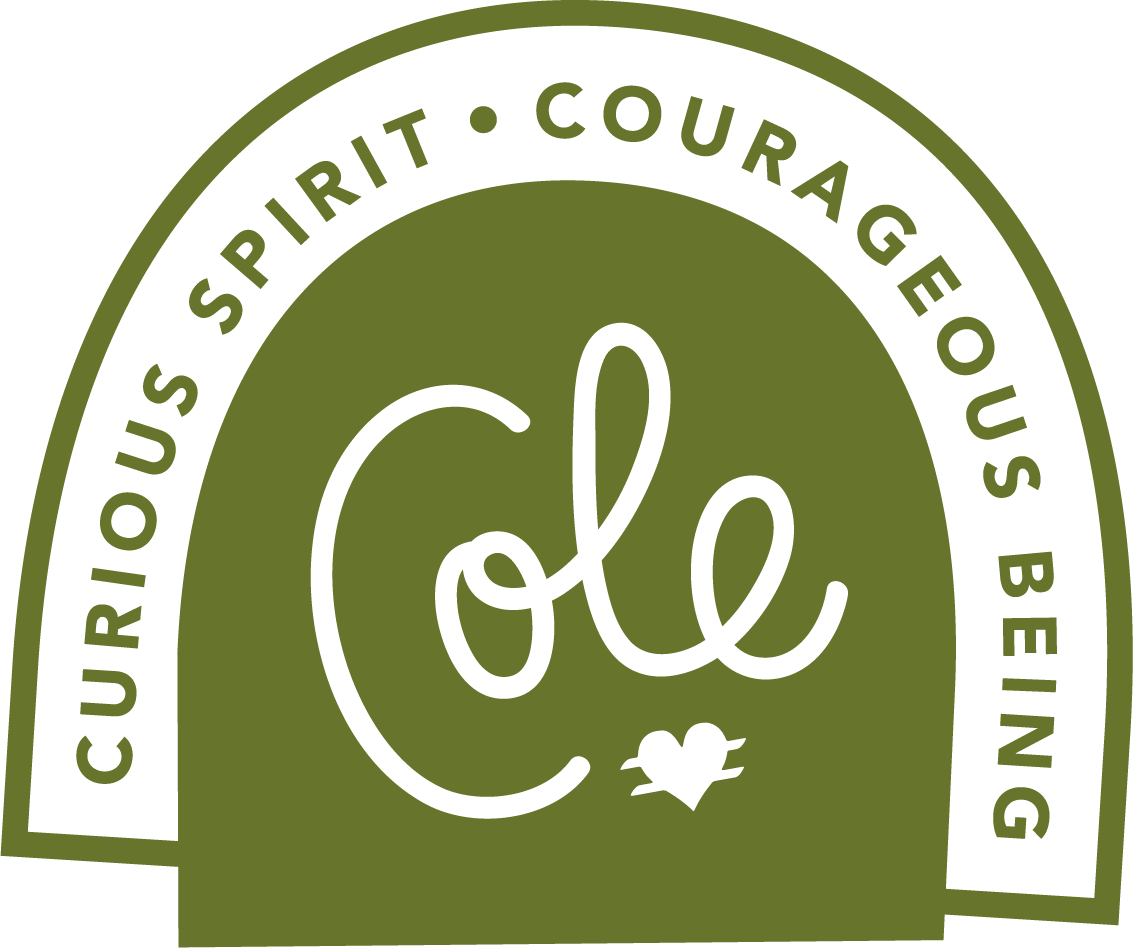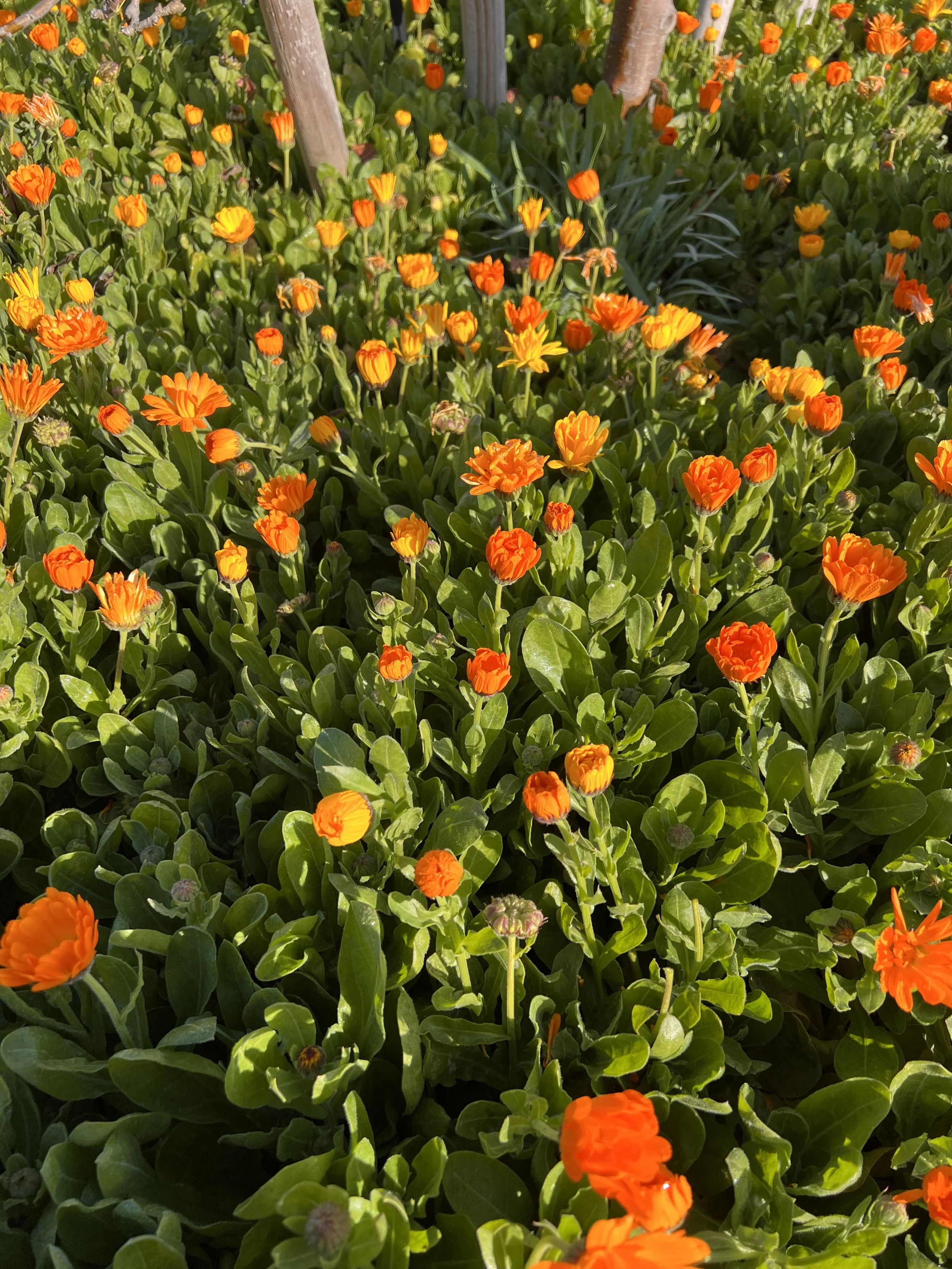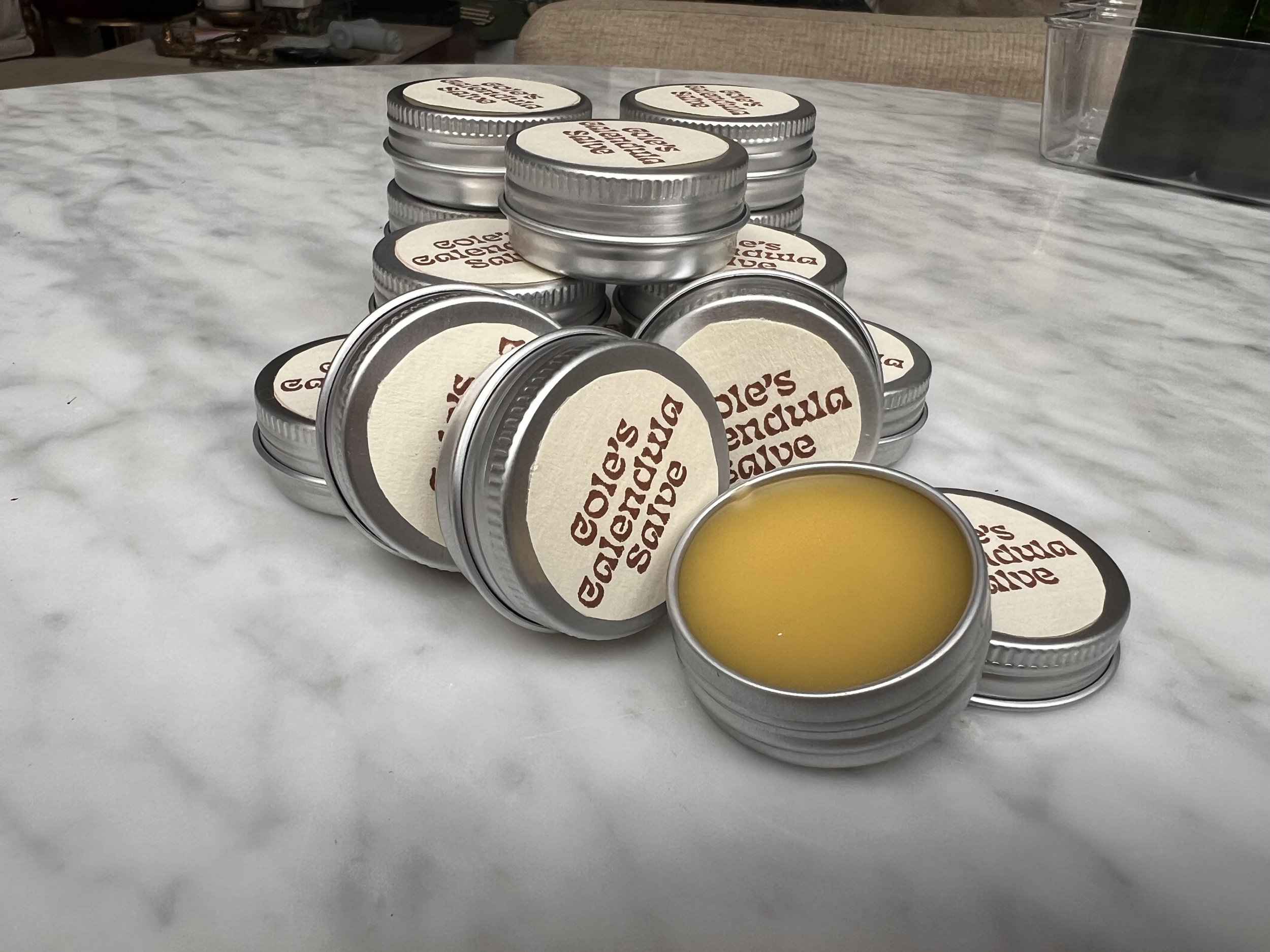Cole’s Complete Calendula Guide: How To Make Infused Calendula Oil, Calendula Facial Oil, Calendula Lip Balm, and Calendula Salve
I wanted to share something I use in my deathwork practice, my home apothecary, my thanabotany work, and my garden with you. It’s something I’ve shared with others very often over the years, and I thought including a giant post here would be helpful to many others.
I’m talking about the beautiful, the stunning—Calendula! Calendula has been a part of many places in my life and maybe you can welcome it into one of your special places.
Calendula aka Calendula officinalis
Calendula is a longtime friend in the garden and in your home apothecary cabinet. Its uses are many, and we have references to calendula’s uses over hundreds of years. It’s a special plant. It’s also called Pot Marigold but sometimes people call them Marigolds (but they aren’t, actually, marigolds). There are several varieties of calendula but they’ll most likely be a shade of orange or yellow.
Calendula in the Garden
I always have calendula growing in my garden!
It’s a good companion plant to tomatoes, peppers, strawberries, salad greens, basil, asparagus, cucumbers, peas, and corn.
It attracts beneficial insects and pollinators.
It deters problem pests, and releases into the soil a natural repellant for nematodes
If you deadhead them regularly, you’ll get more blooms.
Make sure several blooms can totally dry out until you get brown seeds. Save those to replant….or let it reseed itself.
It’s a perennial in zones 9, 10, and 11. It’s an annual in zones 2+.
It likes full sun, but can handle partial sun. It does not like super hot, dead of summer conditions.
You can eat the petals! I use the petals as a pretty pop of color in salads, or sprinkled on the top of a drink as garnish.
Some people save and dry the petals and use them like saffron.
Calendula in Thanabotany
Calendula and Marigolds have been used interchangeably across time for a variety of rituals and traditions connected to end of life, and the afterlife.
Calendula and your Home Apothecary
Calendula has scientifically proven anti-inflammatory properties. It’s why it’s so great for use on the skin! Generally speaking, it tends to take down inflammation, redness, and irritation. If you take a peek on Google Scholar, you can find a lot of scientific papers on calendula’s properties.
Calendula and Deathwork
When working with those nearing end of life, our body chemistry can change, and skin sensitivity can increase. Very simple formulations can soothe the skin and provide comfort without risking irritation. Sometimes, lotions or creams someone loved in the past just won’t absorb the same, or can feel uncomfortable and heavy. It can be helpful to have something simple like calendula salve on hand and give that a try. End of life is a different phase of life, so it’s normal for new and different things to work better, to meet us where we are.
For deathworkers, it’s important to take care of ourselves, too. Gentle, simple, science-based products can help us stay our best. It’s also rewarding to be so innately involved with something we grow, harvest, and make ourselves. For me, it’s rewarding to process an infused oil after months of growing something, harvesting it, drying it, and infusing it for weeks on end. It makes you appreciate everything more deeply and helps us remain connected to the present.
How to make Calendula Oil
To make anything from calendula, the first step is to make an infused calendula oil. This means pulling the amazing compounds and active ingredients inside the calendula plant to the outside and into an oil. Once we get all that good stuff into an oil, we can then use that infused oil as an ingredient which will let us make other things, like lip balm, salves, lotions, and more.
HOW TO MAKE CALENDULA OIL
Harvest calendula flowers, making sure the green sticky part that the petals are attached to stays in tact. That green part is actually what holds much of the actives in calendula that we want to extract! To put this another way….do not just use calendula petals on their own. The petals don’t have nearly the amount of active compounds in them as the green flowerhead base does.
Set your flowers out to dry out of direct sunlight, but in a well ventilated area, for about a week. Some people will dehydrate their calendula flowers, just make sure you are using the lowest heat setting possible.
Then take a jar (I like to use a big canning jar) and put your dried flowers inside.
Pour your oil over the top.
Shake it around making sure the oil gets in every little space.
Store your jar in a cool, dark place. Wait 4-6 weeks, checking your jar weekly.
After the 4-6 weeks are up, take some cheesecloth or a fine mesh sieve and separate the flowers from the oil. I will take all the flowers and squeeze them out by hand because you’ll discover you can get a lot more oil out of them!
Set your new infused calendula oil aside. It’s ready to be used as is, or made into other products.
What BASE oil should you use? There are so many oils you can choose from, and I’ll share the ones I work with over and over.
Grapeseed Oil (cold-pressed)
I use this for any calendula-infused items I want to use for body or lip applications. This is also the least expensive oil per ounce I work with.
Argan Oil (cold-pressed)
I use this for any calendula-infused items I want to use on my face. Argan Oil is non-comedegenic (which means its unlikely to block your pores).
Hemp Oil (cold-pressed)
This is another oil I like to use for anything I’m preparing for use on the body.
How to Make Calendula Body Oil
Once your calendula flowers are done infusing, you’ll have a wonderful oil you can use as an ingredient to make other things with. The easiest thing to do next is to make a Body Oil. All you do is add a little Vitamin E, which I’ll explain below. This is the absolute simplest thing!
INGREDIENTS
Calendula-infused oil (I use calendula infused into Grapeseed Oil for body oil)
Vitamin E
To make your body oil, you’ll measure the total amount of oil you have, and figure out what .5-1% of that is. So, if you have 100 mL of oil, 1mL would be 1%. That’s how you calculate how much Vitamin E oil to add. Vitamin E acts as a stabilizer and will give you more shelf life for your products. That, and storing them in a cool, dry, dark place will too!
How to Make Calendula Facial Oil
I’ll share the absolute simplest facial oil recipe with you. This is what I use on my own face.
INGREDIENTS
Calendula-infused oil (I use argan oil as my preferred base oil for my face)
Vitamin E oil
Take your total amount of oil, and figure out what .5%-1% of that would be. That’s the amount of Vitamin E oil to add. Vitamin E oil acts as a stabilizer and will help keep your facial oil solution in good shape, for longer.
How to Make Calendula Lip Balm
I am delighted to share with you my recipe for lip balm! I first developed this recipe in 2018 when I was making CBD-infused lip balm. Back in 2018, I checked out a ton of books from the library and did a lot of online research. I found and compiled more than 20 different lip balm recipes from those books and websites. I entered them all into an excel sheet and scaled them all to match so I could figure out what percentage of what ingredients would produce the sort of lip balm I was looking for.
Out of an everyday lip balm, I wanted the following:
fewest ingredients possible
smooth application
not glossy, but not matte. Kind of like an ‘eggshell’ gloss that you’d get with paint.
when the tube is cold, I still want it to go on my lips easily
CALENDULA INFUSED LIP BALM RECIPE
I have a list of lip balm supplies I put together on my Amazon storefront here.
60 mL Argan Oil
6 Tbsp Coconut Oil
66 drops Vitamin E Oil
60 g Beeswax
60 mL Castor Oil
This will fill about 35 lip balm tubes.
When I make this recipe, I melt the beeswax in either the microwave or by using a double boiler. Then I add all the other ingredients in, stirring constantly. I use the pipettes I linked in my Amazon storefront to fill the tubes. If your mixture hardens (because it cools down), just microwave it for 15 second increments.
Be sure to keep stirring constantly so your lip balm texture is consistent from tube to tube.
IMPORTANT NOTE Because this recipe does not have stabilizers (ingredients to override the natural properties of coconut oil, which is liquid at room temperature) if you leave the lip balm out in a hot car….it will melt! So, this is a lip balm for keeping at home and out of the hot sun.
How to Make Calendula Salve
A salve, texture-wise, is a lot like lip balm. It’s a nice consistency because people often use salves like ointments. I like to pour it into screw-top metal tins because it works well, looks nice, and the tins are reusable.
Calendula-Infused Salve Recipe
200 mL Calendula-infused Grapeseed Oil
60 mL Coconut Oil
30 mL Vitamin E Oil
40 mL Beeswax
Melt the beeswax, and mix in the other ingredients, stirring constantly. Pour into your tins!
Labeling Your Calendula Products
I like having my products labeled. The easiest way to do this at home is with a Xyron sticker maker. I use the 1.5” wide version. Sometimes I handwrite the labels, but most often I like to make a label and print it out.
I also use shrink wrap to seal my products for when I give them to friends and family. It’s a nice touch!







